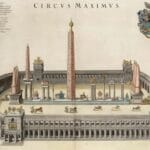Have you ever paused to wonder why a mile is precisely 5,280 feet? It’s a seemingly arbitrary number, yet its origins are far from random. The history of this measurement unveils a fascinating journey from ancient Roman legions to English fields, revealing how evolving standards have shaped our world. For more on historical measurements, check out this link to historical measurement info. Let’s unravel this captivating story together.
The Roman “Mille Passuum”: A Foundation for Distance
Our story begins with the Romans, famed for their engineering prowess and vast empire. To manage their armies and construct their extensive road networks, they needed a standardized unit of distance. They devised the “mille passuum,” translating to “a thousand paces,” where a pace was measured as the distance covered by two steps. But how exactly did this Roman measure evolve into the modern 5,280-foot mile?
From Roman Paces to Modern Feet: Tracing the Evolution
A Roman pace roughly equaled five modern feet, making their “mille passuum” approximately 5,000 feet. While not quite 5,280, the “mille passuum” laid the groundwork for future distance measurements, establishing the concept of a standardized unit based on human movement. This system spread throughout the Roman Empire, influencing subsequent measurement systems across Europe. Over time, regional variations and practical adaptations gradually transformed the Roman mile, paving the way for the next chapter in its history.
The Furlong’s Contribution: Linking Agriculture and Distance
Centuries later, in medieval England, agriculture played a vital role in shaping the mile. The furlong, derived from “furrow long,” represented the length of a furrow that a team of oxen could plow without resting. As land became increasingly valuable, these agricultural measurements gained significance and eventually influenced the standardization of the mile. But how many feet were in a furlong, and how did this unit impact the final length of the mile?
Elizabethan Standardization: Solidifying the 5,280-Foot Mile
During the reign of Queen Elizabeth I, England embarked on a mission to standardize its weights and measures. In 1592, the government officially decreed that the mile should be defined as eight furlongs. With a furlong already established as 660 feet, eight furlongs neatly totaled 5,280 feet. This decision served to harmonize measurements across England, facilitating trade, land transactions, and overall economic activity culminating in the statute mile we recognize today. It wasn’t a random choice; it was a pragmatic effort to integrate existing land measurements into a unified system. So, the question remains: How did the ancient Roman “mille passuum” ultimately morph into the modern 5,280-foot mile? The answer lies in this combination of historical influences and standardization efforts.
Beyond Land: The Nautical Mile’s Divergence
It’s crucial to remember that the statute mile isn’t the only mile in use. Sailors navigate using the nautical mile, a unit based on the Earth’s circumference. One nautical mile equals approximately 6,076 feet, a distinction emphasizing how measurement systems evolve to meet specific needs and contexts. This divergence illustrates the dynamic nature of measurement and its adaptation to different domains.
- The modern mile traces its origins to the Roman system of measurement.
- The medieval agricultural practice of using furlongs significantly shaped the mile’s length.
- Queen Elizabeth I’s reign marked the standardization of the mile to 5,280 feet.
The history of the mile is a captivating fusion of ancient practices, agricultural necessities, and political decisions, all converging to create the measurement we know and use today.
How English Agriculture Influenced the Mile’s Length: Tilling the Soil of Measurement
Delving deeper, have you ever wondered how agriculture in England exerted such a strong influence on the seemingly arbitrary length of the mile? Why did 5,280 feet become the standard, rather than a simpler, rounder number? The answer lies in an intriguing combination of historical factors, with English agriculture playing a surprisingly significant role. Let’s explore how agricultural practices shaped the evolution of the mile to its current length.
The Furlong and Its Agricultural Roots
The furlong, originating from “furrow long,” served as a fundamental unit of measurement in medieval England. It represented the distance a team of oxen could plow in a single, uninterrupted stretch. Agriculture being the cornerstone of the medieval economy, the furlong became deeply embedded in land measurement practices, influencing various aspects of rural life. This established length significantly impacted the growth rate of the English economy.
From Fields to Statute: The Standardization of Measurement
As England transitioned from an agrarian society to one characterized by growing trade and commerce, the inconsistencies in regional land measurements became increasingly problematic. Differing lengths for the furlong across various regions led to confusion and disputes, hindering efficient transactions. By the 16th century, Queen Elizabeth I recognized the need for standardization and initiated reforms to unify measurements across the realm. Since a furlong equaled 1/8 of a mile, this helped harmonize measurements across England, streamlining trade and land transactions and leading to the Statute mile we use today. How exactly did agriculture in England shape the mile’s evolution to 5,280 feet? The answer lies in the integration of the furlong into the standardized system.
A Lasting Connection to the Land
The enduring presence of the mile, even amidst the global adoption of the metric system, underscores its historical importance and deep cultural connections. It serves as a tangible link to our past, reminding us of the agricultural practices that shaped our world. The standardization at 5,280 feet wasn’t a random occurrence. It was a deliberate choice reflecting a complex interplay of historical, economic, and agricultural factors.
Key Takeaways:
- The mile evolved from the Roman “mille passuum,” representing a thousand paces.
- The furlong, an agricultural unit defining furrow length, profoundly influenced the mile’s eventual length.
- Elizabethan England’s standardization efforts cemented the mile’s length at 5,280 feet, integrating agricultural measurements into the legal framework.
Ultimately, the modern mile represents a convergence of historical influences, with agriculture in England playing a pivotal role in determining its final form. Its history is a testament to continuous refinement, blending ancient practices with the ever-changing needs of society.















